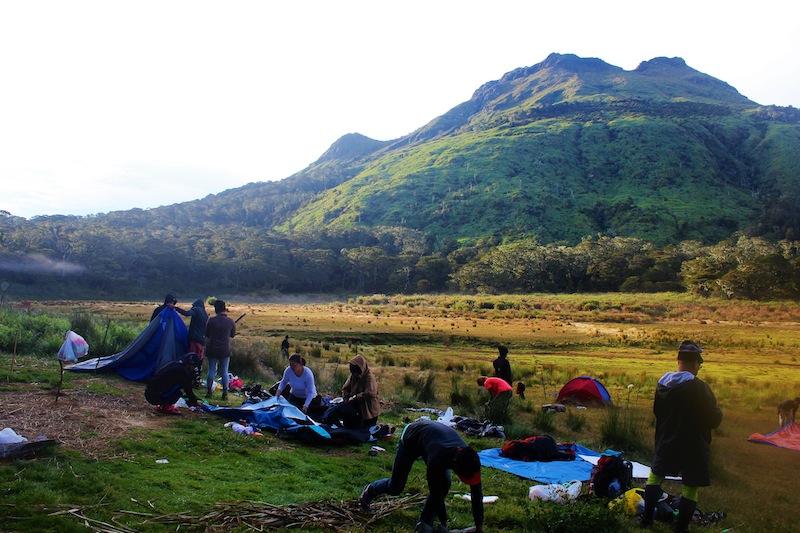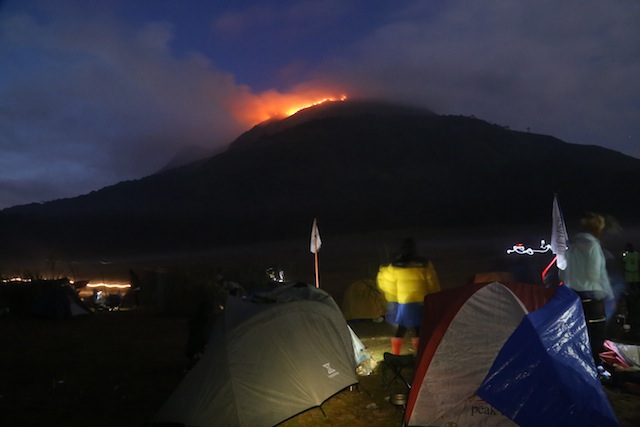DAVAO CITY (MindaNews / 5 Feb) – The tourism officer of Sta. Cruz municipality in Davao del Sur is urging authorities to increase the number of trekkers that can climb up Mt. Apo, which was set to 50 per trail per day in 2017 as a response to the 2016 forest fire around its peak that lasted over two weeks.
 Trekkers take a rest before assaulting the peak of Mt. Apo. MindaNews file photo by JULES L. BENITEZ
Trekkers take a rest before assaulting the peak of Mt. Apo. MindaNews file photo by JULES L. BENITEZ
During the “Wednesdays at Habi at Kape” forum, Sta. Cruz municipal tourism officer Julius Paner urged the Protected Area Management Board (PAMB) to reconsider revisiting the existing policy limiting the allowable number of trekkers to Mt. Apo Natural Park, from 50 to 100 a day for each of its six trails.
The policy was imposed on April 12, 2017, the day PAMB lifted the “indefinite closure” of Mt. Apo because of the forest fire, believed caused by trekkers who left behind an unattended camp fire, that engulfed its peak for over two weeks in March 2016.
The fire razed about 115 hectares of forests and grasslands, including some century-old trees.
Paner said discussions are ongoing on revisiting the existing regulation to further boost the municipal government’s effort to promote ecotourism as a way to strike a balance between “tourism and environmental protection.”
Paner said while regulating trekking activities helps to preserve the country’s highest peak and prevent similar massive fire, the carrying capacity of the Sta. Cruz trail can still be expanded, explaining that the 50-limit rule, or a maximum of 300 climbers per day with the six trails of Mt. Apo combined, is quite a “small number.”
He said the 100 trekkers per trail limit, or a total of 600, is still “manageable.” Paner noted that trekking is a low-impact ecotourism activity, which can potentially help the local economy.
 A group of mountaineers and bikers from Cotabato City watch the fire at the peak of Mt. Apo in March 2016. The Cotabato group claimed three unidentified mountaineers who slept at the peak and cooked there may have caused the fire. Photo courtesy of TUTIN SAPTO / Cotabato All-Terrain Bikers Association (CATBA)
A group of mountaineers and bikers from Cotabato City watch the fire at the peak of Mt. Apo in March 2016. The Cotabato group claimed three unidentified mountaineers who slept at the peak and cooked there may have caused the fire. Photo courtesy of TUTIN SAPTO / Cotabato All-Terrain Bikers Association (CATBA)
Mountaineers may climb Mt. Apo via its six trails: in Kidapawan, Makilala, and Magpet in North Cotabato; and Digos, Sta. Cruz, and Bansalan in Davao del Sur.
Aside from limiting the number of trekkers, the PAMB Ecotourism Management Committee “unanimously agreed and approved” that a “no camping policy” at the peak area will be included in the Unified Trekking Policy of 2015 and the LGU’s Camp Management Plan.
“The local government generates small revenues from tourism. Ecotourism is a balance between tourism and environmental protection. We don’t want mass tourism. Most of the benefits from ecotourism will go directly to the communities—tour guides, porters, habal-habal drivers, and sari-sari stores,” Paner said.
He said the local government strictly implements the existing regulation of 50 trekkers a day pending the decision of the PAMB. He said Sta. Cruz trail has 110 porters and 70 tour guides.
The municipal government is also set to stage the Mt. Apo Boulder Face Challenge and Mt. Apo Sky and Vertical Race on April 18 and April 25 to 26, respectively, Paner said.
He added they limit the number of runners, mostly European and Southeast Asian, for the Boulder Face Challenge to 50 and 100 for the two-day out-and-back Sky and Vertical Race. (Antonio L. Colina IV / MindaNews)
